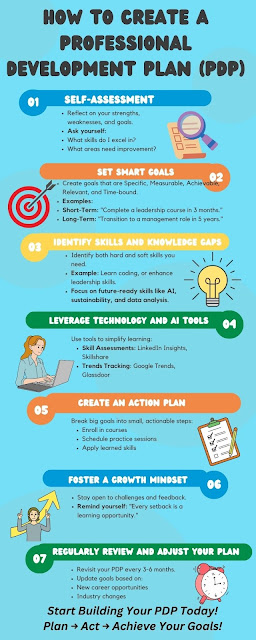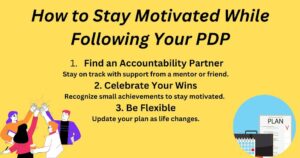Are you ready to succeed in today’s competitive job market? A Professional Development Plan (PDP) is essential for your career growth. A LinkedIn survey shows that 94% of employees would stay longer at a company that invests in their development.

- Career Growth and Advancement: A clear PDP allows you to track your progress and identify areas for improvement.
- Increased Job Satisfaction: Research shows that 70% of employees are more likely to stay at a company that invests in their career development, which a PDP encourages.
- Personal Fulfillment: A PDP ensures that your professional goals align with your personal values, making your work more engaging and fulfilling.
- Confidence Boost: With clear goals in your PDP, you will feel more confident in your ability to meet milestones and overcome challenges.
How to Create a Professional Development Plan: Step-by-Step Guide

Step 1: Self-Assessment
Key Self-Assessment Questions:
- What are your main strengths and skills?
- What do you need to improve to advance in your career?
- How do your personal values match your career goals?
Performing a self-assessment is crucial to learning how to create a professional development plan that is realistic and personalized.
Step 2: Set SMART Goals
Examples of SMART Goals:
- Short-Term Goal: “Complete a leadership course in the next 3 months.”
- Long-Term Goal: “Become a manager within 5 years.”
Step 3: Identify Skills and Knowledge Gaps
For example:
- Leadership Skills: A course on Emotional Intelligence to develop self-awareness and empathy in leadership roles.
- Data-Driven Decision-Making: Skills like Data Analysis or Python programming can open up new opportunities in analytics-heavy roles.
Fresh Tip: Focus on future-proof skills like AI literacy, digital transformation skills, and sustainability practices. As industries evolve, these emerging fields will be crucial to your growth.
Step 4: Leverage Technology and AI Tools
Top Tools to Use:
- AI-Powered Skill Assessments: Use platforms like Plato.ai or Skill share to analyze your skill set and receive personalized learning recommendations.
- Industry Trend Trackers: Tools like Google Trends, LinkedIn Insights, or Glassdoor provide real-time data on the most in-demand skills and careers, helping you align your goals with future opportunities.

Step 5: Create an Action Plan
Example Action Plan for Becoming a Project Manager:
- Enroll in a PMP certification course within 30 days.
- Study for the PMP exam for 2 hours each week.
- Apply for the exam after completing the course.
Step 6: Foster a Growth Mindset
Tips for Building a Growth Mindset:
- View challenges as opportunities to learn.
- Ask for feedback from peers and mentors.
- Stay open to new experiences and keep improving your skills.
Step 7: Regularly Review and Adjust Your Plan
Review Tips:
- Set milestones to assess your progress regularly.
- Stay updated on industry trends and adjust your PDP as needed.
- Be flexible and ready to change your goals as new opportunities arise.
 |
| How to Create a Professional Development Plan |
Professional Development Plan Examples
Example 1: Entry-Level Marketing Coordinator
Name: Sarah Johnson
Current Role: Marketing Coordinator
Career Goal: To become a Marketing Manager within the next 3 to 5 years
Short-Term Goals (1-2 years):
Obtain a Digital Marketing Certification (e.g., Google Analytics, HubSpot Inbound) within the next 6 months.
Action Steps:
- Research and compare different digital marketing certification programs.
- Enroll in the chosen certification course and complete it within 6 months.
- Apply the new skills learned in my current role to demonstrate expertise.
Tools/Resources:
- Use Coursera or Udemy for online courses.
- Leverage LinkedIn Learning to access industry-relevant content.
2. Develop Project Management Skills by leading 2-3 marketing campaigns within the next 12 months.
Action Steps:
- Volunteer to lead a small-scale marketing campaign within the next 3 months.
- Seek feedback from the marketing manager on areas for improvement.
- Take a project management course to enhance my skills.
Tools/Resources:
- Enroll in a project management course on LinkedIn Learning.
- Utilize Trello or Asana to manage project timelines and tasks.
Long-Term Goals (3-5 years):
Transition to a Marketing Manager Role.
Action Steps:
- Identify key skills and qualifications required for a Marketing Manager position.
- Develop a plan to acquire those skills through on-the-job experience, training, and mentorship.
- Network with marketing leaders within the organization and seek out a mentor.
Tools/Resources:
- Use LinkedIn to connect with industry professionals.
- Attend marketing conferences for networking opportunities.
Example 2: Mid-Level IT Project Manager
Name: Michael Chen
Current Role: IT Project Manager
Career Goal: To become a Senior IT Project Manager or Program Manager within the next 5 years
Short-Term Goals (1-2 years):
Obtain the PMP Certification within 12 months.
Action Steps:
- Enroll in a PMP exam preparation course.
- Study for the PMP exam and schedule it within 12 months.
- Apply the PMP principles and methodologies to current projects.
Tools/Resources:
- Utilize PMI resources for study materials.
- Use LinkedIn Learning for additional project management courses.
2. Develop Stakeholder Management Skills.
Action Steps:
- Enroll in a course on effective stakeholder management and communication.
- Practice active listening and clear communication with project stakeholders.
- Seek feedback from my manager and project team members.
Tools/Resources:
- Explore courses on Coursera focused on communication skills.
- Use tools like Slack for effective team communication.
Long-Term Goals (3-5 years):
- Identify key skills and qualifications for a Senior IT Project Manager or Program Manager position.
- Seek out opportunities to lead larger, more complex projects.
- Develop expertise in program management and strategic planning.
- Join professional organizations like PMI for networking.
- Attend relevant workshops and seminars to enhance skills.
How to Stay Motivated While Following Your PDP
- Accountability Partners: Find someone to help keep you accountable, like a mentor or colleague.
- Celebrate Milestones: Recognize your small wins to stay motivated.
- Adjust When Needed: Life changes, so be ready to update your PDP.

How to Create a Professional Development Plan
Common Mistakes to Avoid When Creating a PDP
- Setting Unrealistic Goals: Make sure your goals are achievable.
- Lack of Flexibility: Be open to adjusting your plan as your career changes.
- Neglecting Regular Reviews: Schedule regular check-ins to track your progress.
Conclusion
Key Takeaways:
- A PDP is essential for tracking your career growth and achieving your goals.
- Set SMART goals and regularly review your progress to stay on track.
- Leverage technology and resources to fill skill gaps and enhance your learning.
- Stay motivated by celebrating milestones and adjusting your plan as needed.
FAQs
1. What is a Professional Development Plan (PDP)?
A PDP is a strategic document that outlines your career goals and the steps you need to take to achieve them. It helps you focus on skill-building, track progress, and stay motivated.
2. Why is a PDP important for career growth?
A PDP is important because it:
- Clarify your career goals.
- Enhances job satisfaction by aligning work with personal values.
- Helps track progress and adapt to industry changes.
3. How do I start creating a PDP?
Start by performing a self-assessment to identify your strengths and areas for improvement. Then, set SMART goals and outline actionable steps to achieve them.
4. How often should I review my Professional Development Plan?
Review your PDP every 3–6 months to track progress, adjust goals, and stay aligned with career changes and industry trends.
5. What tools can help me create a more effective PDP?
Refine your PDP using AI tools, online courses (Coursera, LinkedIn Learning), and career coaching platforms. These resources can provide valuable insights, skill assessments, and learning paths tailored to your career goals.



